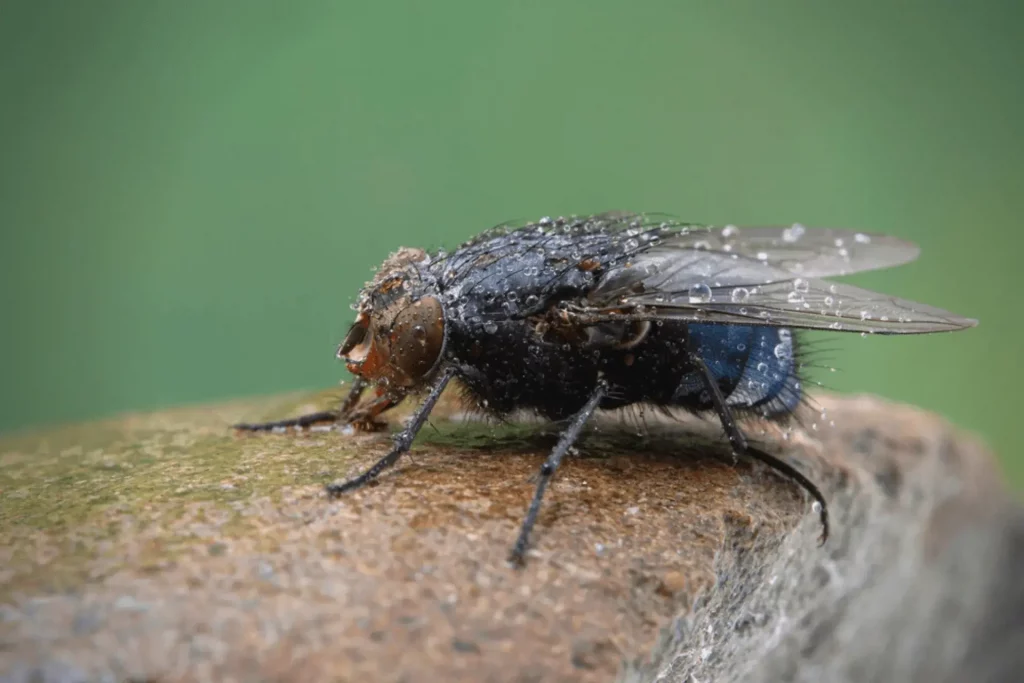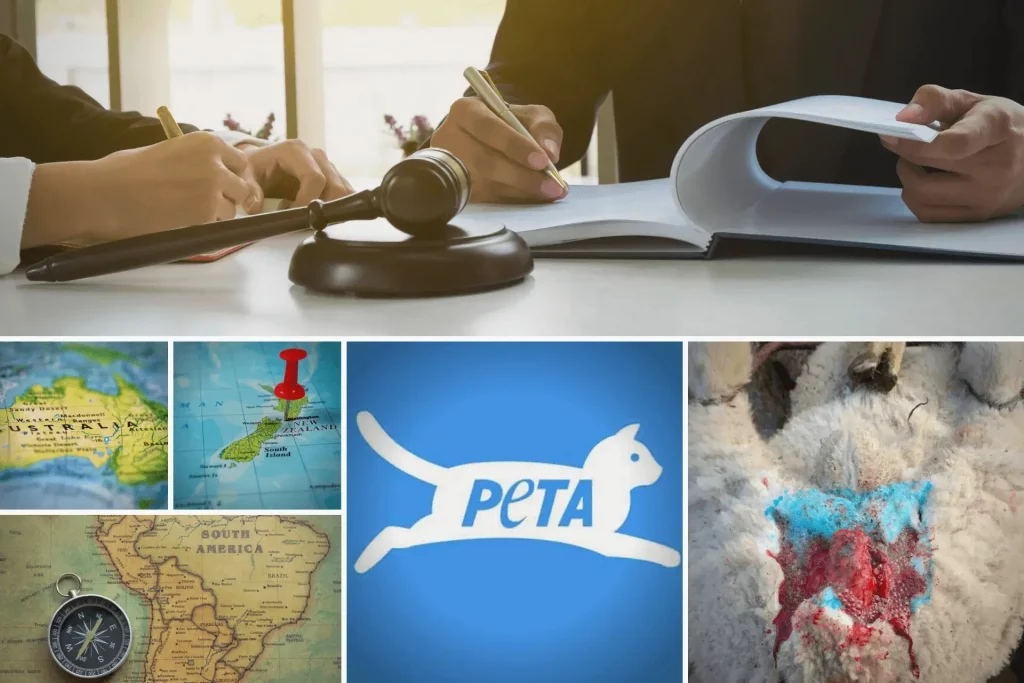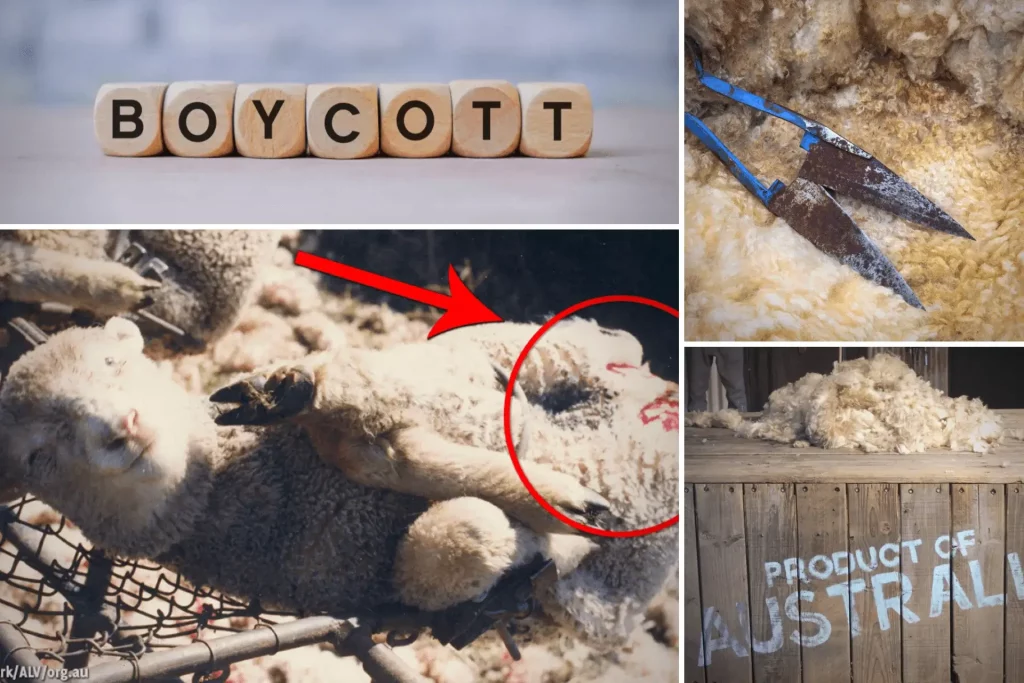Australia produces the vast majority of the world’s wool. Merinos are the most regularly grown sheep in that area, and they are particularly designed to have wrinkled skin, which means they produce more wool per animal than other breeds.
Because of this abnormal excess of wool, many sheep collapses and even die from heat exhaustion during the summer months, and the wrinkles gather urine and moisture due to the stress. Fly eggs are laid in the folds of the skin by flies attracted to the wetness, and the born maggots can devour the sheep alive.
To avoid this so-called “flystrike,” Australian farmers use a horrific operation known as “mulesing,” in which workers force living sheep onto their backs, tie their legs with metal bars, and, frequently without administering any analgesics, cut big pieces of skin from the animals’ behinds or attach vise-like clips to their skin until it expires and sloughs off. Both treatments are quite uncomfortable.
Table of Contents
What Exactly is Mulesing and Why Should We Know About it?
Mulesing removes skin from the area around a sheep’s buttocks, resulting in scar tissue formation in areas where wool does not develop.
Once the region has been scarred, it will no longer generate fleece. Because of this, it is less likely to include feces and other organic debris, which are known to attract fly larvae, which are known to transmit the parasitic infection known as flystrike.
1. Skin Strips Are Removed Without the Use of Anesthetics:

Mulesing is removing skin strips from around the hips of merino sheep. Because the tissue that forms over the incision does not produce wool again, it’s much less likely to attract flies in the future.
The Australian National Farmers Federation report estimates that 3 million sheep per year might die a lingering death from flystrike if mulesing is not implemented.
What appears to be a positive development for the animals has a significant drawback: the skin strips are removed without anesthetics. The treatment is carried out while the sheep are fully aware, and as a result, the process is extremely unpleasant for the animals involved.
Following that, the wound must be allowed to heal without any additional examination. It is also possible that the blowfly lays eggs in this exposed lesion, resulting in the sheep becoming contaminated despite the precautions taken.
2. Mulesing Against the Flystrike Disease:

Merino wool is a kind of wool generated from the fur of merino sheep. These sheep have been grown so that their skin is extremely wrinkly and wrinkled. As a result, they can generate a greater quantity of fleece.
On the other hand, these skin folds produce a variety of issues: When moisture gathers in the folds, it also collects feces and urine, which are also kept in this location.
As a result, it attracts the blowfly, which may be found mostly in Australia and New Zealand and is responsible for the so-called flystrike. Flies deposit their ova in the warm and moist folds of the sheep’s skin, where fly larvae hatch and develop into adult flies.
The maggots establish a parasitic nest in the animal’s skin and can transmit diseases. This infestation has the potential to be deadly for the sheep.
What Does Mulesing-Free Mean?
We were aware that mulesing was associated with agony for the animal, which was viewed less as a living individual and more as a resource, created only to extract the largest amount of wool in the shortest amount of time possible, even if it means harming the animal during the shearing process.
However, we were unaware that it was a breeding practice developed in Australia in the 1930s that involves eliminating the tail and a portion of the anal and perianal meat, particularly from Merinos breed sheep, to improve their fertility.
So that infectious diseases do not spread, the animal’s rear end is continually exposed to feces and wet substances, which provide a perfect environment for flies to attack and lay their eggs to stop the spread of infectious diseases.
In addition to causing pain and suffering to the animal, these diseases require producers to waste a considerable volume of wool, hurting their bottom line profits.
Interesting Read: Is Merino Wool Good for Hot Weather?
Why Should We Care That Our Favorite Merino Wool Sportswear Is Mullesing-Free?
Mulesing has long been considered a routine surgical treatment for most sheep, particularly in Australia, where most commercial wool is produced.
Some sheep farmers utilize this strategy to keep their sheep alive by keeping them from becoming infected with an insect-borne disease. When performing a mulesing surgery on a lamb, skin is removed from around the lamb’s breech to produce an area of exposed, stretched skin.
Because the scarred skin does not have folds or creases to collect moisture and excrement, it is less prone to attract blowflies, which might lead to the death of the sheep if the sheep is not treated immediately. Mulesing is an unpleasant surgical treatment for sheep that can be avoided if the right precautions are taken.
No animal should be subjected to the agony and stress that this type of surgery imposes on them. The wool industry is investigating alternatives to mulesing to improve sheep’s wellbeing.
Fortunately, there are alternative methods of protecting sheep against these insects, but they are costly in the long term. Because of this, mulesing-free merino wool goods may be a little more expensive. Researchers have discovered that while mulesing causes agony equivalent to castration, the discomfort lasts up to 48 hours.
Is Mulesing Legal?

Yes, although not in all nations. According to the PETA organization (People for the Ethical Treatment of Animals), it is unfortunate that Australia accounts for 25 percent of the world’s Merino wool output.
As stated on Wikipedia, this practice is still allowed and declared essential by the Australian Association of Veterinarians, who describe it as a “not perfect solution, but a required solution.”
In New Zealand, on the other hand, where mulesing was formerly highly widespread not very long ago, the practice was outlawed following lobbying from animal rights organizations.
In particular, South Africa and South America are among the other parts of the globe where Merino sheep are extensively grown for meat and wool. Although mulesing appears more prevalent in these instances, it appears far less ubiquitous overall.
Our research turned up an official statement from the National Association of Wool Producers in South Africa, claiming that mulesing is to blame and that 90 percent of producers claim to be free of the practice.
On the other hand, when it comes to South America, it appears that the severe environment does not provide any evident concerns of infection in the backs of the animals, which may explain why mulesing is not as prevalent there.
Options to Contrast Diseases in Sheep Other Than Mulesing:
Although it appears to be primarily the hot and humid environment of Australia, which is unfavorable for breeding Merinos sheep, it appears to be a significant factor in expanding larvae and illnesses in the animal danger regions.
This breed has been selectively bred throughout time to have skin as wrinkled and plentiful as possible, resulting in an extremely rich mantle in nutrients.
When the warm environment of Australia is combined with an artificial overabundance of fur, it becomes clear that the pain associated with illnesses is produced specifically by the actions of humans, as well as by intense and blind breeding.
As a result, mulesing today may be avoided by breeding more slowly and precisely, with less emphasis on number and more emphasis on the quality of the output.
Among the most feasible alternatives to the mulesing procedure are:
- Cleaning and managing animals are accomplished by spraying the shearing of the at-risk sections.
- Flytraps are to be placed around the flocks of birds.
- Genetics and selection of breeds that produce less wool growth and are thus better suited to Australia’s warm climes.
When It Comes to Anti-mulesing Measures, What Can Consumers Do?

Animal cruelty is wrong, and the strong statement that any of us can convey to the wool business is that concerned customers and community members will not support it. To ensure that wool items are ethically produced (from sheep that are not mulesed, at the very least), check with the store before purchasing.
As a way of demonstrating to Australia’s decision-making that the Australian people are outraged by the brutal treatment of animals by the Australian wool industry, If you’re writing a public letter of your local newspaper, consider the following crucial points:
- A brutal and out-of-date practice, mulesing, involves removing the skin of an animal’s behind without any pain medication.
- Australia’s worldwide reputation is tarnished as the Australian wool business continues to mules sheep, industrial raise sheep for ‘ultra-fine’ wool, and export lives animals, all of which are harmful to the industry.
- Consumers’ worries about animal cruelty have prompted retailers across Europe to boycott Australian wool from mulesed sheep in reaction to the boycott.
- When it comes to supporting the wool sector, the Federal Government has done so without hesitation in the past. It is past time for the Australian government and the wool business to recognize that animal cruelty will not be tolerated by the Australian people or the worldwide public.
Frequently Asked Questions:
Is mulesing a cruel practice?
A contentious technique, mulesing, is used to transport goods. According to the animal rights organization, mulesing is harsh and painful, and more humane options are available. PETA also claims that sheep may be avoided maggot infection by using more humane procedures such as special diets and spray cleaning rather than mulesing.
What exactly is the problem with mulesing?
Although mulesing is an amateurish attempt to generate smoother skin that won’t gather moisture, the exposed and raw sores frequently become infected or fly struck as a result. Even after being subjected to mulesing mutilation, many sheep endure protracted, torturous deaths due to flystrike. Sheep mutilation is not only horrible, but it is also counterproductive.
What is the purpose of mulesing among farmers?
Tail docking and mulesing are two sheep husbandry methods used to keep flystrike at bay. Tail docking may also be necessary to fulfill the standards of particular markets. Developing a breeding program that reduces breech wrinkle/cover makes it possible to reduce the reliance on mulesing to avoid flystrike.
Is mulesing a legal practice in the United States?
Mulesing is the technique in which lambs between 6 and 12 weeks of age are confined on their backs while strips of skin are hacked away from the posterior of their backs. Mulesing causes lambs great pain, anxiety, and stress, yet it is still lawful to perform this treatment without administering any pain reliever to the animals at this time.
Wrapping it Up:
Mulesing is a painful procedure in the wool industry that is often overlooked. A sheep’s buttocks are sliced to prevent it from becoming infected with flystrike, a maggot infection that can be fatal to the animal. Not only is the process uncomfortable for the animal, but it also increases the number of flies.
As a result of the lack of blood vessels or nerves in this section of their body, mulesing can result in permanent sores and lameness in some cases of mulesing. Fortunately, there are other methods you can use to prevent these problems without mutilating your animals, such as using chemicals sprayed on their rear ends or clipping away at their fleece with scissors instead of shears.
For example, using chemicals sprayed on their rear ends or clipping away at their fleece with scissors instead of shears can both be effective (or ideally both).

